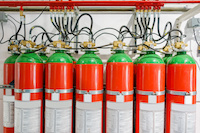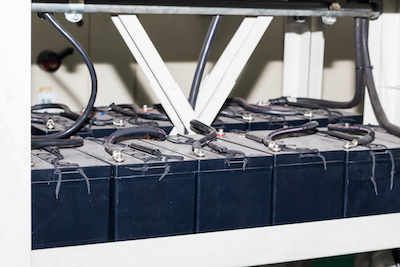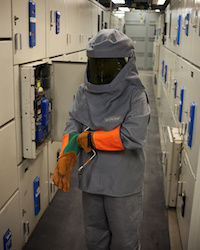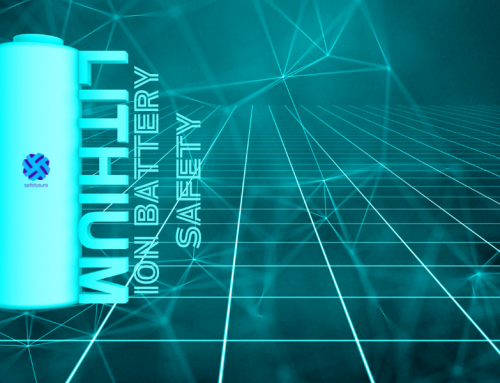On the outside, Data Centres seem very innocuous places. Outsiders often see them as the domain for computer nerds with very few risks but…they can present a range of critical hazards that need to be managed with some degree of certainty. Managing work safety in a data centre is a considered approach and one that needs to be well thought out if it is to prove effective. In this article we talk about data center health hazards and data center safety hazards.
Data centres are popping up all over the world at breakneck speeds. With 24-hour operations being conducted every day of the year they aren’t your typical workplace. Many of them are becoming a hybrid workplace where workers and ‘rack renters’ are moving in and out multiple time per day.
While many data centres are built around providing service for an individual organisation, many data centres provide access to individual users to rack their servers in a safe environment. There are inherent work health and safety risks for both. In this article we take a brief look at some of the inherent hazards in data centres and ways that Data Centre managers and owners can take control of them.
Safety & Health Hazards in a Data Centre
In assessing safety in a data centre there are some key process hazards that must be considered. These include:
- Fire suppression systems;
- UPS Battery Charging Facilities;
- Heat;
- Noise;
- Arc Flash;
- Fuel storage and handling;
- Chemical exposures;
- Work at Heights;
Let’s take a brief look at these.
Fire Suppression
Data centres are hot environments and a fire could cause substantial issues for data retrieval. That’s why most data centre operators use a range of suppression systems that flood the room with an inert gas if a fire is detected. The inert gas smother the fire and displaces any oxygen such that the fire can’t survive. Remember the fire triangle. Fire suppression systems are great for equipment but not for people. If there’s no oxygen then the ultimate effect is no human life. Fortunately most systems provide a visual and auditory warning for people in the room that they need to get out or die. The complications arise when a techy guy is busily working on his computer wearing headphones and listening to Madonna. If he or she is not in the immediate vicinity of the fire and cant see the visual cues, he/she will likely feel very cold as the room floods with the suppression agent just before he/she pops off to sleep and doesn’t wake again.
Open access data centres are prone to occasional occupant access and, on a summer day, they can be very cool places to hang out. Effective safety systems need to be implemented to ensure that a suppression agent flooding doesn’t claim a life and that if an individual is trapped inside, there are means for emergency personnel to access to retrieve an asphyxiating operator. While we make a little gest out of the scenario, it’s very serious business and data centre owners must prepare for the day when this scenario may occur.
UPS Battery Charging
Data centres need to run during power supply shortages so owners consider a range of options to supply immediate needs power to keep operating. Depending on the size of a centre, uniteruptable batteries are kept in banks for the use in an emergency. Nowadays we seldom use lead acid batteries because of the production of significant volumes of hydrogen during the charging process from lead acid batteries. We do however use a range of sealed batteries like AGM that also produce hydrogen but generally at a lower rate. These batteries can increase in hydrogen output particularly in times of high rate charging, like immediately after they have discharged.
The problem with hydrogen is that it has a relatively low flash point and can produce a significant explosion is ignited. Well you say, we don’t have any smoking in the battery charging area! The problem lies within. While you may not have smokers you may have a range of switchgear or other electrical appliances that could just help that hydrogen to go “BOOM”
By having a battery charging room assessed against a hazardous area classification standard, you can ensure that the probability for the BOOM is diminished significantly. There are a range of professionally qualified hazardous area assessors who can work through this at the design stage and certify that the inherent design will not cause a BOOM.
Heat
Apart from the normal fire risk, the management of heat in a data centre is critical to keeping the racks cool and operating within their specifications for performance. When heat is not managed, not only does the rack hardware suffer, so does the individuals inside the centre. Most cooing systems are built for a range of ambient temperatures and sometimes have difficulty in coping on those hot days so it’s important to identify any outliers in terms of heat.
Of course, we always spec cooling according to budget and as the data centre expands the cooling becomes inadequate. Good Data Centre Operators should consider the people as well as the hardware.
Noise
There’s nothing like the noise of a data centre to make you calm…is there? Data centres run a range of air conditioning, switchgear routers and servers that when combined together can produce significant noise levels above threshold values for safe communication and exposure to prevent noise induced hearing loss.
Obviously a great data centre will ensure the acoustics are adequate to attenuate the drum of the servers but most don’t consider it until the hardware has been installed. Data Centre managers should consider the aspects of noise on individuals working within the walls but also those outside who may be subject to environmental noise issues.
By having and effective plan for monitoring and control of noise in a data centre, owners can mitigate long term health effects in employees and contractors and lessen the probability of a future litigation.
Arc Flash
Most data centres utilise a lot of power in order to keep their machines running. In order to get the power to the racks data centres must transform High Voltage input power to Low Voltage to supply equipment. Obviously, there is energy loss (as well as heat build-up) in the transformation of HV to LV so centres want to avoid step down like the plague.
Unfortunately, the use of HV and, in some cases LV, may result in scenarios where an arc flash hazard is present. Arc flash may occur when several electrical conductors are placed close to each other, with significant fault currents flowing through them. When this occurs, ionization of the air can take place as a result of various factors – such as differences in potential – which leads to a low resistance path and allows current to flow through the air gap between conductors.
In dusty environments arc flash is also more prevalent hence the need to keep centres clean. By having a range of mitigation techniques and equipment defined in AS 3000 Wiring Rules, you can mitigate your site risks for arc flash. You can read more on Arc Flash here
There are also a range of scenarios where arc flash resistant clothing and rescue procedures may be appropriate. Data Centre managers must ensure a program exists around arc flash protection and that appropriately trained & qualified personnel inspect centres on a regular basis to identify arc flash issues.
Fuel Storage and Handling
Most data centres rely on a range of alternative energy supplies to keep the wheels spinning and while UPS is great for a short-term outage, most large centres install generators to ensure continuity of supply. Obviously maintaining supply may require one or multiple generators which need fuel to burn.
The safety complication arises from risks in fuel storage and handling systems that supply power generation equipment. Significant quantities of stored fuel may require classification of the site under Dangerous Goods or Workplace Health & Safety regulations and present risks for building owners in the event of a fire. Data Centre manages should also ensure that there is adequate fire protection systems to prevent significant fire events from fuel storage.
With fuel also comes issues of environmental contamination so ensuring that environmental safety obligations are met is paramount to the Data Centre maintaining its’ license to operate. Bunding of enclosure and eliminating risk of ground contamination of fuels must be undertaken to mitigate environmental risks.
Maintainers of generation equipment must be vigilant in ensuring the efficacy of fuel lines and hosing. Consideration should also be given to location of generation equipment in respect of exhaust gases. By situating generators close to air handling systems the risk of a building contaminated with diesel particulates or asphyxiants is highly likely.
By mapping out the process and risks with generator operation, Data Centre manages can ensure the safety of their sites without compromising operational efficiencies.
Data center health hazards | Chemical Exposures
Maintainers in data centres use a cocktail of chemical (mainly solvents) for cleaning purposes however in a range of centres, cooling tower chemical may also be stored and decanted.
Data Centre managers must evaluate all chemicals coming to site to ensure that the risks of exposure to site personnel are lessened and that the co-location of incompatible chemical cannot result in increased site fire hazards. Across Australia, obligations for minimising exposure to hazardous substances are well defined and Data Centre Managers should aim to understand the what why how where and when of chemical use is occurring at their centre.
With open centres, controlling the inward flow of chemical to site becomes increasingly complicated. There are known incidences of individuals turning up with unlabelled jars of cleaning fluids such as isopropyl alcohol, acetones and lubricants.
Work at heights
If you’ve got high racks they’ll be no doubt that your staff or your visitors will be up and down ladders which inherently increases the risks of falls. Worse still if you have maintenance contractors back and forward on site there’s a high probability that they’ll be on roof tops or climbing down the side of buildings. Working at heights can be a killer and to maintain safety in your data centre, you must have a system for limiting work at heights to trained and competent people. Some key questions to ask:
- Do I have people on the roof maintaining air conditioning?
- Where are my generators? Are they installed on rooftops?
- How are my windows cleaned (if you’re lucky enough to have any)?
- What is the height of my highest rack…how do people access it?
Summary
At the start of our article we highlighted that Managing work safety in a data centre is a considered approach and one that needs to be well thought out. A work-related or serious non-employee incident can have significant effects on the up time of your data centre. While hazards appear insignificant from the outside, the approach should always be to lessen effects and certainly eliminate any hazards that can kill or significantly injure your staff, your contractors or the visitors to your Data Centre. Great safety in a data centre is serious business and don’t over prioritise the equipment in lieu of staff and contractors.
Read more Work Health & Safety News
Safetysure is a professional work health & safety consultancy providing specialist services to assists businesses manage complex work health & safety issues.









Leave A Comment